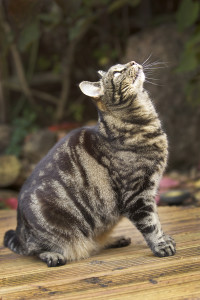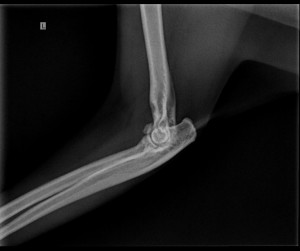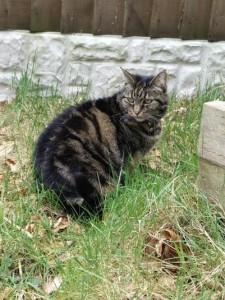Hollybank’s Brave Pet of the Month… Stella
 Stella is a beautiful tabby cat who presented to us at Hollybank veterinary centre because of lameness in her front left leg. Stella had become reluctant to go upstairs and jump on the sofa. She was showing abnormal behaviour whilst resting, such as suddenly jumping up and running away. Despite otherwise being fine she was just not herself and had become less interactive with her owners. Stella was already on a non-steroidal anti-inflammatory medication for previous complaints of lameness in her front legs. However, she was lame on her left leg despite still using these.
Stella is a beautiful tabby cat who presented to us at Hollybank veterinary centre because of lameness in her front left leg. Stella had become reluctant to go upstairs and jump on the sofa. She was showing abnormal behaviour whilst resting, such as suddenly jumping up and running away. Despite otherwise being fine she was just not herself and had become less interactive with her owners. Stella was already on a non-steroidal anti-inflammatory medication for previous complaints of lameness in her front legs. However, she was lame on her left leg despite still using these.
On examination, Stella was very reactive on extension and palpation around her left elbow. Given Stella’s age, gradual presentation and her level of lameness our suspicion was degenerative changes in the joint such as osteoarthritis. Osteoarthritis is a progressive condition and it is inevitable that with its progression animal’s will need additional pain relief and management.
 For cats, this is where it can get complicated….
For cats, this is where it can get complicated….
Most additional pain relief medications are in tablet form and some are known to be bitter; given that cats are notoriously good at spitting out and hiding tablets we often find ourselves limited with the pain relief that we can give, simply because we can’t get it in!
For Stella, we tried adding in additional pain relief tablets but despite her owners hard work and effort she was difficult to tablet. Next we opted to try a liquid version of the same drug, this was in fact a human drug and the flavourings added meant that Stella would not take this either! During this time, Stella’s lameness had got worse and she had begun to toilet inappropriately in the house, most likely as she was too painful to climb in and out of her litter tray.
Unfortunately, for many cat’s, treatment or management of a condition can be delayed or even not embarked on due to tableting difficulties. It is a major limiting factor and for some conditions there are no alternative options. However, for Stella we had another option. We elected to inject a long acting steroid injection directly into the joint space in her elbow. This provides a potent anti-inflammatory action at the source of the problem.
 The procedure does require some sedation but at this point it was the next sensible step.Whilst sedated we took the opportunity to x-ray both elbows to confirm our suspected diagnosis. Both of the elbows showed degenerative changes and new bony formation, especially the left one.
The procedure does require some sedation but at this point it was the next sensible step.Whilst sedated we took the opportunity to x-ray both elbows to confirm our suspected diagnosis. Both of the elbows showed degenerative changes and new bony formation, especially the left one.
Stella stayed in with us following the procedure for 24-hours of strict rest and made the most of lots of fuss from myself and our nurses. She went home the following day with a gradual return to normal activity. There was some risk that Stella might not respond to this therapy but within a few days Stella’s demeanour had improved, she was keen to go outside again and was using her litter tray! The improvement was brilliant and she seemed overall a much happier little cat.
 Stella will remain on non-steroidal anti-inflammatories for the time being; in some cases we can stop these medications completely but it is not uncommon for animals to need these ongoing. Stella is also taking a joint supplement (yes a tablet she will eat!) The supplement will not reverse any of the changes already in the joint but will help to maintain a healthy joint environment and support the cartilage between her bones.
Stella will remain on non-steroidal anti-inflammatories for the time being; in some cases we can stop these medications completely but it is not uncommon for animals to need these ongoing. Stella is also taking a joint supplement (yes a tablet she will eat!) The supplement will not reverse any of the changes already in the joint but will help to maintain a healthy joint environment and support the cartilage between her bones.
A few weeks on and Stella is still doing well. However, she has occasionally come home lame after spending time outside; it is really positive that Stella feels comfy enough to go and explore but because of this new found comfort she is likely to be over doing it on her expeditions. On further detective work by her owners she is climbing fences and jumping from heights!
Moderating our cats exercise is another limitation we face but completely restricting a normally outdoor cat indoors can often be more stressful to them. Our main aim after all is ensuring a good quality of life therefore we have to find a balance; as long as Stella is only occasionally lame after a big expedition and remains pain free and happy for the most part then we are happy too and we will continue to monitor her closely.
Please also see one of our older posts related to this subject
‘Arthritis in our feline friends’.

